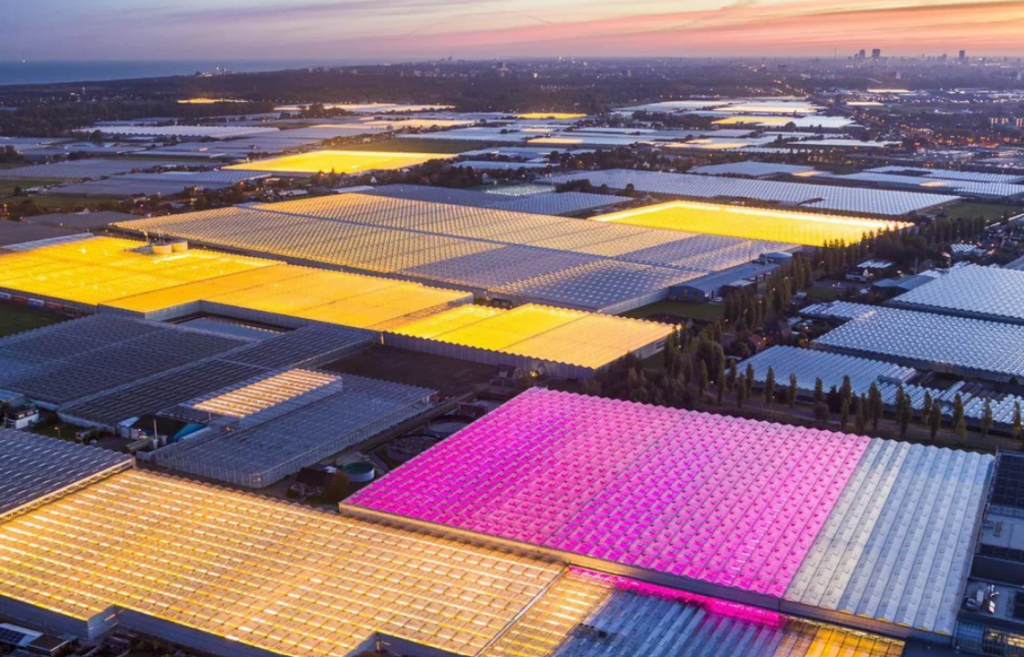Today’s issue is on vertical farming. If you’re anything like me, you’ve probably been hearing about this technology for years.
It was supposed to be the next big thing; a panacea for solving global food production.
But while it did grow into a $7 billion market, there are signs that this growth is stalling out.
Some big vertical farms have recently gone bust, and last year VC funding in the space collapsed:

You’d be lucky to find vertically farmed products at the grocery store today. The idea that vertical farming could ever make a serious dent in the multi-trillion-dollar global agricultural market seems increasingly questionable.
In this issue, we’ll explore the vertical farming landscape:
- Is vertical farming economically viable?
- Is it really any more sustainable than traditional open-field methods?
- What lessons can we learn about investing in agtech?
Let’s go 👇
Table of Contents
Asian avocado imports are skyrocketing 🥑
Supply needs to catch up. You can invest.
In this issue, we explain the benefits of traditional farming vs the new “vertical” methods.
One way to realize those benefits is through a company called AGRI.

AGRI Developments is a leading private alternative asset company specializing in unique agriculture opportunities in Asia.
The latest opportunity? Growing Hass Avocados in the Philippines.
Why Hass Avocados in the Philippines? 🇵🇭
- Huge unmet demand. Asian nations are developing a taste for avocados. Imports are growing by 48% per year. (Asian demand for avos is expected to pass the US & Mexico combined by 2030!)
- High prices. It’s not easy to grow avocados in Asia. So almost all avocados are imported — meaning prices are nearly 2x higher than the Western Hemisphere.
- Perfect suitability. As the only country in Asia capable of growing high-quality Hass avocados in volume, the Philippines is uniquely positioned to meet the demand.
- Strategic location. The Philippines is next to key import hubs of China, South Korea, Japan, and Hong Kong.
- Low operational costs. It’s an ideal location for avocado cultivation and production.
AGRI developments offers access to one of the few commercially viable sources of avocado development in Asia.
The offering is for individual avocado trees, a minimum of 10 for $13.75k. Base-case annual yields are expected to be 18%+, with a minimum price agreement already in place.
Invest in AGRI Developments to be part of a project that not only promises financial returns, but also contributes to sustainable and responsible development.
What is vertical farming?
Vertical farming has its “roots” (heyoo!) in hydroponics, the growing of plants without soil.
The idea behind vertical farming is simple and intuitive: by growing food indoors, in stacked layers, you can produce higher yields while using less soil, water, and land.

Instead of soil, hydroponically grown plants get all their essential nutrients from water-based solutions, delivered through a drip system, or as a mist (aeroponics).
Rather than watering the soil around a plant, hydroponics lets you water/deliver nutrients to a plant directly. Theoretically, this can give you huge efficiency gains compared to traditional methods, saving 90-95% of water.

Hydroponics naturally lends itself to indoor farming, since the precision required to deliver nutrient solutions in the right quantities is hard to achieve outdoors.
As such, hydroponics pairs well with the time-tested greenhouse structure, which combines the benefits of indoor precision with sunlight.
But here’s a little-known fact: Just like you don’t need soil to grow pants, you don’t need the sun either!
Yes, the sun facilitates photosynthesis. But the sun isn’t the only thing capable of providing this energy. Really, any light source will do, even artificial light.

And just like hydroponics, the benefits of growing under artificial light are all about precision and control.
Unlike the sun, an LED grow light can run 24 hours a day and have its color & angle tailored to promote plant growth.
So far, the case for vertical farming seems strong!
Stacking and towering techniques
Ordinarily, stacking trays of plants on top of each other isn’t a great idea.
- The top layers block all the sunlight, depriving the bottom layers
- Excess water drips to the bottom layers and soaks the plants
But when you eliminate the need for sun and soil (and water directly) these problems disappear. You can now build vertically to maximize yield.
Best of all, since vertical farms use airspace, not land, you can place these structures wherever you want — including in big cities with millions of mouths to feed.

Companies like Plenty, meanwhile, pursue what they call “true” vertical farming (although we’ll opt for the less-partisan “towered” vertical farming).
Unlike the stacked approach, towered farming involves fundamentally changing the orientation of the plants’ growing plane. Plants aren’t just placed vertically, they’re grown straight up and down on columns.

Whether towered or stacked, though, most vertical farms only grow the same few products.
Both Plenty and Bowery, for instance, focus almost exclusively on leafy greens like lettuce, kale, and spinach.
This is no coincidence. In fact, it illustrates the big challenges vertical farms have run into.
Vertical farming has tricky economics
Vertical farming advocates roll out some compelling figures.
When compared to traditional open-field cultivation, vertical farms:
- Use 98% less water
- Yields 10-20x more per acre, and
- Can grow plants 2-3x faster
But focusing on these metrics misses the bigger picture.
Vertical farming certainly brings some improvements over traditional farming, but are these improvements cost-effective?
Unfortunately, so far the answer seems to be no.
Vertical farms do outperform traditional farms based on certain metrics, but this outperformance is purchased at too high a cost.
Vertical farms are expensive to start..
Starting a traditional farm is expensive, but it’s not that expensive.
The all-in cost varies depending on size and the type of crop you want to plant, but estimates for a decent-scale operation are around 1 – 5 million.
Starting a vertical farm, however, is another beast entirely.
To launch a vertical farm, you need to:
- Buy land and construct the building that houses the farm (or retrofit an existing space)
- Buy and install all the high-tech hydroponic and lighting equipment
- Install custom sensors and control systems to modulate the indoor environment (for temperature, air quality, humidity, etc.)
- And, if you’re like many of the vertical farms hoping to automate labor, buy or build the robots and machines
The costs of all this equipment and technology add up, resulting in some phenomenally expensive facilities:
- Fifth Season (which went under) spent $27 million on its farm in Braddock, Pennsylvania
- AeroFarms invested over $53 million in its Danville, Virginia farm
- And Plenty plans to spend more than $300 million on its vertical farm “campus” in Richmond, Virginia

..and expensive to operate
Vertical farms aren’t just costly to launch, they’re costly to operate.

Take energy costs, for example.
A single LED is cheap, but how about a warehouse full of LEDs running 24/7? Plus, you’re competing with open-air farms that literally get their sunlight for free.
Higher labor costs might seem odd, especially considering that vertical farms invest plenty in automation. But traditional farms actually don’t need that many workers to operate.
In the US, for instance, there are about 1.9 million farms, but only about 2.6 million people who work on them.
That would imply an average of about 1.4 workers for a typical 450-acre farm (although this is probably an understatement due to the presence of seasonal, part-time, or unregistered workers).
In comparison, a company like Bowery has six people on their leadership team alone!
The fact is, despite faster growth, higher yields, and using less water, vertical farms face higher overall operating costs than traditional farms.
In fact, one estimate calculated that the breakeven cost of production for leafy greens was nearly 5x higher for vertical farms than traditional outdoor ones.

Most foods are too inexpensive to support the high costs
These high costs might be sustainable if revenue could support them. But farm food just isn’t sold for much.
Starchy products like rice, potatoes, and wheat sell for around $1-2 a pound retail.
Fruits can fetch higher prices, but adapting them to indoor farming is challenging. Apple and avocado trees are big and heavy. Building a structure to contain them would be costly and a bit bizarre.

So this leaves leafy greens as the best bet.
Spinach and kale usually fetch over $3 per pound, especially when you can brand your product as organic and pesticide-free (which vertical farms can easily do since the plants are grown in a controlled indoor environment).
Moreover, these plants are well-suited to indoor farming, with vertical farms able to harvest leafy greens 4-6x more frequently.
As a result, leafy greens are one of the few products you can vertically farm profitably – which is why seemingly every vertical farm startup sells them.
Conventional farms receive lots of subsidies
Vertical farms don’t compete on an even playing field.
In countries like the US and Germany, crops produced by conventional agriculture get extensive subsidies, keeping their prices artificially low.
That dynamic only compounds the difficulties of the vertical farming business model, resulting in a challenging startup environment:
- Infarm, a Berlin-based startup once valued at more than $1 billion, declared bankruptcy last year
- Bowery faced layoffs late last year and a steep valuation markdown
- French-based Agricool, whose investors included Danone, went bankrupt in 2022
- And AeroFarms only recently reemerged from a restructuring process
In their current form, the economics of vertical farms don’t seem compelling.
But what about the hidden costs and externalities? Perhaps vertical farms fare better on sustainability?
Is vertical farming more sustainable?
Even if vertical farming fails to offer a more profitable business model for agriculture, it could potentially offer a more sustainable one.
And while the regulatory system today doesn’t always incentivize sustainable agriculture, future initiatives could reward farming that’s better for the planet.
Let’s evaluate the sustainability of vertical farming along three major dimensions: water, land, and carbon.
Vertical farms use water more efficiently (mostly)
Conventional agriculture uses a lot of water.
Get this: Of all the freshwater resources the world uses each year, over 70% goes toward farming.

With rising temperatures from climate change likely to increase global water stress, vertical farming’s vastly more efficient resource use is a step in the right direction.
Still, we can’t give vertical farming full passing marks here.
Reported figures often reflect the water efficiency of vertical farms once they’re in operation.
Building out a vertical farm’s physical structure and machinery from scratch likely takes a ton of water, but those figures aren’t reported, so it’s hard to say how it impacts overall water use.
Vertical farms preserve land
The sustainability of vertical farms most clearly shines in land preservation, for two main reasons:
- Vertical farms have a vastly superior yield-per-acre for many crops. Same amount of food, less land needed
- Since plants are grown in a controlled indoor environment, vertical farms don’t need pesticides or fertilizers.
As a result:
- Vertical farms lead to less deforestation (agriculture is a primary motivation for clearcutting), and
- They contribute to developing healthier topsoil, with conventional farming methods increasingly pointed to as a cause of soil quality decline.
Carbon emissions: A mixed bag
Carbon is a tricky one. In theory, the fact that vertical farms contribute to fewer food miles (the distance food needs to travel before it gets eaten) should reduce transport-related emissions.
But in practice, for the type of food that vertical farms could grow, food miles make up a fairly small share of overall carbon emissions.

In fact, emissions from the farm on which food is grown account for a much greater share, which is a problem for vertical farms.
Remember, vertical farms don’t use real sunlight — they use a bunch of LEDs that stay turned on.
About 60% of power generation in the US comes from fossil fuels. And while the power that generates those LEDs may one day come from renewable resources, that isn’t the case today.
The main lesson of vertical farming
I’ve been critical of vertical farming so far. And the truth is, as a VC-hyped model whose underlying economics have always looked questionable, the industry is an easy target.
But the rise and fall of vertical farming provides an instructive lesson for investing in agtech.
The main problem with vertical farming appears to be an over-reliance on high-tech systems, to the point where efficiency gains no longer justify the expense.
But this doesn’t mean that things like hydroponics, LED lighting, and indoor farming are fundamentally uneconomical.
Want proof? Look at the Netherlands.
Despite its very small size, the Netherlands is actually the world’s second-largest exporter of agricultural products by value (behind only the US!)
A big reason for this is the development of modern greenhouses, more than 25,000 acres of which dot the country (about twice the land area of Manhattan).

These greenhouses strike the right balance — they’re advanced enough to benefit from technology, while still sufficiently old-school to keep costs low.
More generally, cost-effective optimization opportunities in agriculture probably won’t be found in rebuilding the entire farming process from the ground up (like vertical farms have tried to do.)
They’re more likely to be found in making specific improvements to time-tested methods, like greenhouses or open-field cultivation.
Humans don’t need to reinvent the wheel here. We’ve already proven we can grow food economically.
This fact should form the foundation for startups and investors looking to create agtech’s future. 🥬
That’s all for today.
Reply to this email with comments. We read everything.












